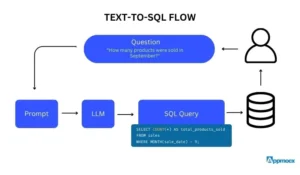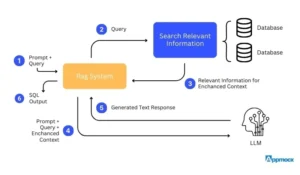Use Cases of Text-to-SQL / What is Text-to-SQL?

Text to SQL is changing the landscape of Business Intelligence (BI) offering a variety of applications that are making an impact:
Streamlined Data Exploration
By enabling users to express their questions in language through Text to SQL technology makes data analysis easier and faster without the requirement of crafting SQL queries. Saving a substantial amount of time and energy in the process.
Efficient Report Generation
Text, to SQL makes it easier to create reports by streamlining the process and improving usability, for teams.The feature allows users to easily define the data they need using language of dealing with intricate SQL commands.
Enhanced Decision-Making
By enhancing the accessibility of database queries through Text, to SQL technology people at every level can now search for data. Uncover valuable insights on their own. This leads to a culture of decision making based on data, across the organization.
Given the progress, in natural language processing and machine learning technologies Text to SQL systems are poised to enhance their accuracy and efficiency opening up fresh avenues for creative advancements.
Understanding How Text-to-SQL Functions

Text, to SQL technology converts everyday language queries into SQL commands by following a sequence of actions:
User Query Input: The procedure begins when a user enters a query using natural language.
Natural Language Processing (NLP): The system uses techniques, in Natural Language Processing ( abbreviated as NLP) to examine the input and pinpoint elements, like entities and intent within a given context.
Query Interpretation: Sophisticated AI algorithms, like language models (LLMs) analyze the polished input to understand what the user is trying to achieve.
SQL Generation: SQL Generation involves creating a SQL statement that precisely reflects what the user wants based on the query provided.
Query Optimization: Refining the SQL query with the help of AI powered optimizers involves enhancing its efficiency based on an analysis of the database schema and structure.
Database Execution: Executing the optimized query against the database is the step in the process.
Data Retrieval: The database provides the required data as per the query that was executed.
Result Processing: Processing the outcome entails transforming the data into a organized and clear format through the use of natural language or visual aids.
Presentation: The results are then presented in a way that’s easy for users to understand and interpret.
Important Factors to Consider
AI and Machine Learning Models
The success of Text to SQL systems relies on aspects.
The success of Text to SQL systems depends on factors. Text to SQL systems utilize cutting edge AI and machine learning models, like:
- Many advanced models, like BERT and GPT are used to understand the meanings and complexities of language, in real world contexts.
- Using Neural Machine Translation ( NMT ) models to transform natural language queries into SQL syntax. (Natural language to SQL)
Retrieval Augmented Generation (RAG)
RAG enhances the accuracy of Text to SQL systems by incorporating details from sources prior to crafting the SQL query. This approach guarantees a comprehension of the query environment and pertinent data arrangements, resulting in heightened precision in SQL query generation and outcomes.
Continuous Learning
Numerous systems that convert text to SQL utilize learning features that allow them to improve their accuracy gradually by interacting with users and receiving feedback.
Advantages of Using Text-to-SQL
Text to SQL technology is changing the game for how companies engage with their data by providing benefits, here are the
Advantages of Text-to-SQL:
Democratizing Data Access
By letting people ask questions to databases in language of technical jargon, like SQL code, Text to SQL makes it easier for everyone in a company to access data giving employees the ability to uncover important information even if they don’t know SQL.
Consequently companies can cultivate a culture centered around data enabling informed decision making to be integrated into all aspects of their operations.
Time Efficiency
Text to SQL accelerates data access by reducing the need for technical teams to create queries enabling business users to retrieve information without having to depend on IT or data teams for assistance.
By making data access more efficient and user friendly it saves time. Also empowers technical teams to focus on tackling challenging and important tasks.
Improved Decision-Making
The use of Text to SQL technology enhances the speed at which businesses gain insights and make decisions. It enables users to effectively retrieve data from databases using a text-to-SQL prompt and interpret the findings promptly. This capability helps decision makers respond swiftly to changes in the market landscape and meet evolving customer needs and emerging prospects. Real-time access to data promotes agility and responsiveness in the business environment.
Reduce Training Expenses
By using Text, to SQL solutions of requiring SQL training programs for employees to learn SQL from scratch organizations can focus on introducing user friendly natural language interfaces to their workforce.
Text to SQL technology enables companies to develop a workforce that’s more inclusive and efficient while also being driven by data analysis to promote innovation and enhance their advantage.
Obstacles and Constraints
Boundaries, in the Field of Text to SQL Technology:
Ambiguity in Natural Language
One of the issues we face is the uncertainty in how people ask questions using everyday language or specialized terms that might not perfectly match database formats. Research suggests that around 20 percent of user queries encounter problems such as ambiguity or being impossible to answer.
In order to address this challenge effectively and enhance Text to SQL systems performance:
- Lets clarify any terms.
- Grasp the context.
- Ask users for clarification when necessary.
Data Protection and Access Management
With the improvement of Text, to SQL systems comes the concern of security risks they may bring about for data accessibility, in businesses today.
Key security precautions comprise:
- Restricting data queries to those users who are authorized. That’s what Role Based Access Control (RBAC) does.
- Ensuring handling of queries to safeguard against SQL injection attacks is crucial.
- To secure data it is essential to employ encryption and masking techniques for protection purposes.
- Keeping records of all queries, for security oversight. That’s what audit logging is all about.
By giving importance to these measures companies can guarantee effective access to data.
Complex Queries
Text to SQL systems work well for queries. They can face difficulties when dealing with intricate or specialized SQL structures presenting certain challenges in the process.
- Crafting queries that require multiple joining tables.
- Interpreting requests, for SQL functionalities like window functions or recursive queries, with accuracy.
- Optimizing the speed of database searches, for datasets.
To tackle these challenges successfully
- Incorporate expertise specific to the field into the systems framework. Especially focus on business rules and operations.
- Utilize query optimization methods to improve effectiveness.
- Users are given the opportunity to adjust or amend the queries generated as required.
By overcoming these constraints and challenges Text to SQL technology is able to progress providing reliable solutions that are both robust and effective.
Text-to-SQL Within Semantic Layers
By combining Text, to SQL technology with layers effectively enhances access to data and functions while addressing various issues linked to independent Text, to SQL systems.
The method involves running human written questions through a layer that incorporates predefined business rules and metrics to analyze them efficiently and accurately before converting them into optimized SQL queries that adhere to the organizations data structures and business regulations.
The fusion of Text, to SQL and layers offers significant benefits:
Enhanced Accuracy and Consistency
Incorporating layers with Text to SQL boosts the precision and reliability of data analysis:
- In the layer consistent interpretation of business terms is ensured through predefined metrics and dimensions, for all queries.
- The semantic layer helps reduce mistakes in queries by handling computations and data conversions effectively.
- User inquiries are smoothly linked to the data origins. Accurately combined to avoid any discrepancies that might arise from constructing queries manually.
Improved User Experience
Enhancing data extraction and analytics through an approach makes the entire process more intuitive and efficient:
- Users have the option to ask questions using business language without needing to understand the data structure beneath it all.
- Results are produced faster through the use of the layer to streamline data access and aggregation processes.
- Maintaining uniformity among users and software enhances confidence in the data and analytics procedures.
Scalability and Governance
Integrating Text to SQL, with a layer effectively addresses challenges faced by enterprises:
- Centralized data governance guarantees that all requests adhere to the data policies and security measures set by the organization.
- Achieving scalability and managing complexity are aspects here; a semantic layer effectively navigates data connections and sizable datasets to facilitate the smooth growth of Text, to SQL functionalities.
- Minimal disturbance is ensured by handling changes to the core data structures at a level that’s more understandable to users.
Effective Strategies for Implementing Text-to-SQL
In order to effectively utilize Text, to SQL technology in practice it is crucial to adhere to the practices established within the industry Here are some strategies to guarantee a smooth implementation:
Clear and Well-Defined Natural Language Inputs
Creating a Text to SQL system starts with top notch training data.
- Create well crafted questions in language to effectively understand what the user wants.
- Teach the system using a range of questions that touch on levels of difficulty and scenarios involving databases to improve its flexibility
- Enhance understanding of industry related questions by incorporating terms and employed business expressions.
Integration with Semantic Layer
By combining Text, to SQL with a layer the accuracy and consistency of queries are greatly improved.
- The semantic layer acts as a connection point that transforms business language into the database formats and connections.
- By incorporating this system integration approach in operations ensures that all queries are generated consistently throughout the organization which helps in interpreting business metrics reliably.
- By using a layer, in the system helps enforce predetermined business rules and data governance regulations when crafting SQL queries.
Ongoing Improvement Driven by User Feedback
In order to maintain and improve the performance of a Text, to SQL system in the run:
- Lets create a system, for monitoring user engagement and assessing search outcomes over time.
- Consistently review feedback to identify issues where the system misunderstands user intentions.
- Use these findings to adjust NLP models and expand the systems understanding of query patterns.
Appmocx’s Semantic Layer for Smarter Decision-Making
Text, to SQL technology is changing how companies use data for making decisions by enabling tech users to ask databases questions using everyday language. When paired with a layer this tech addresses obstacles and boosts data access, throughout the business.
Appmocx semantic layer platform enhances its Text, to SQL functionality with an accuracy rate and simplifies the process of generating queries. Through providing an user friendly perspective of data accessibilities Appmocx guarantees a transformation of natural language inquiries, into well tailored SQL statements that correspond with your companys data structures and operational regulations.
Uncover the ways in which Appmocx can assist your company in unleashing the capabilities of Text, to SQL technology. Our semantic layer platform ensures that data interactions are user friendly and precise while prioritizing security in line, with your business goals. Request a demonstration to dive deeper into the details.